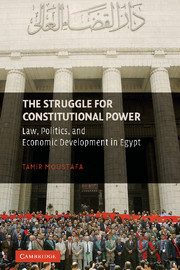Book contents
- Frontmatter
- Contents
- List of Figures and Tables
- Acknowledgments
- 1 Introduction: Law versus the State
- 2 The Politics of Domination: Law and Resistance in Authoritarian States
- 3 The Establishment of the Supreme Constitutional Court
- 4 The Emergence of Constitutional Power (1979–1990)
- 5 The Rapid Expansion of Constitutional Power (1991–1997)
- 6 Executive Retrenchment and an Uncertain Future (1998–2005)
- 7 Law, Development, and Democracy: A Critical Appraisal
- APPENDIX A SCC Justices and Commissioners
- APPENDIX B The Egyptian Constitution
- APPENDIX C Law 48 of 1979 Governing the Operations of the Supreme Constitutional Court of Egypt
- APPENDIX D Figures on Supreme Constitutional Court Rulings
- Bibliography
- Index
3 - The Establishment of the Supreme Constitutional Court
Published online by Cambridge University Press: 27 July 2009
- Frontmatter
- Contents
- List of Figures and Tables
- Acknowledgments
- 1 Introduction: Law versus the State
- 2 The Politics of Domination: Law and Resistance in Authoritarian States
- 3 The Establishment of the Supreme Constitutional Court
- 4 The Emergence of Constitutional Power (1979–1990)
- 5 The Rapid Expansion of Constitutional Power (1991–1997)
- 6 Executive Retrenchment and an Uncertain Future (1998–2005)
- 7 Law, Development, and Democracy: A Critical Appraisal
- APPENDIX A SCC Justices and Commissioners
- APPENDIX B The Egyptian Constitution
- APPENDIX C Law 48 of 1979 Governing the Operations of the Supreme Constitutional Court of Egypt
- APPENDIX D Figures on Supreme Constitutional Court Rulings
- Bibliography
- Index
Summary
“Commerce and manufacture can seldom flourish long in any state which does not enjoy a regular administration of justice, in which the people do not feel themselves secure in the possessions of their property, in which the faith of contracts is not supported by law and in which the authority of the state is not supposed to be regularly employed in enforcing the payment of debts from all those who are able to pay. Commerce and manufacture, in short, can seldom flourish in any state in which there is not a certain degree of confidence in the justice of government.”
Adam Smith, An Inquiry into the Nature and Causes of the Wealth of Nations“The law is on holiday.”
Shar'awi Gom'a, Gamal 'Abd al-Nasser's Minister of InteriorWhy did Egypt's authoritarian regime establish an independent constitutional court in 1979 when only twenty-five years earlier it had worked to undermine judicial power? From the standpoint of the mainstream comparative law and politics literature, the birth of the Egyptian Supreme Constitutional Court presents a surprising anomaly: an entrenched regime facing no credible challengers established an autonomous court with the ability to strike down regime legislation.
The motives for judicial reform make somewhat more sense when viewed from a political-economy angle. The passages above by eighteenth-century economist Adam Smith and Nasser's Minister of Interior nicely illustrate one of the principal tradeoffs that authoritarian regimes face when they remove constraints on their power.
- Type
- Chapter
- Information
- The Struggle for Constitutional PowerLaw, Politics, and Economic Development in Egypt, pp. 57 - 89Publisher: Cambridge University PressPrint publication year: 2007



